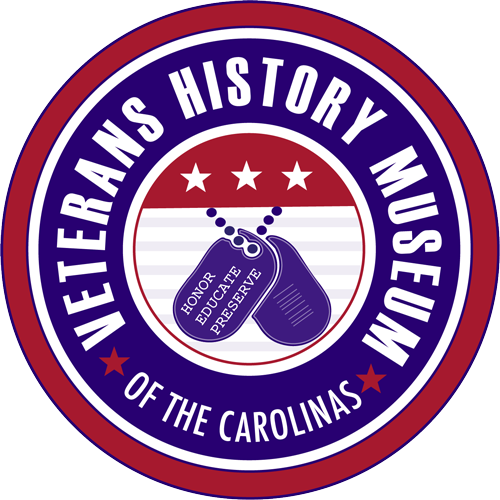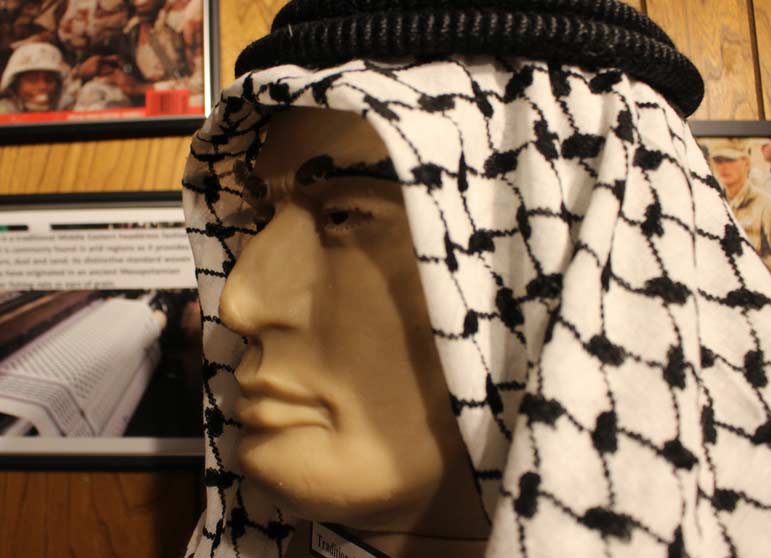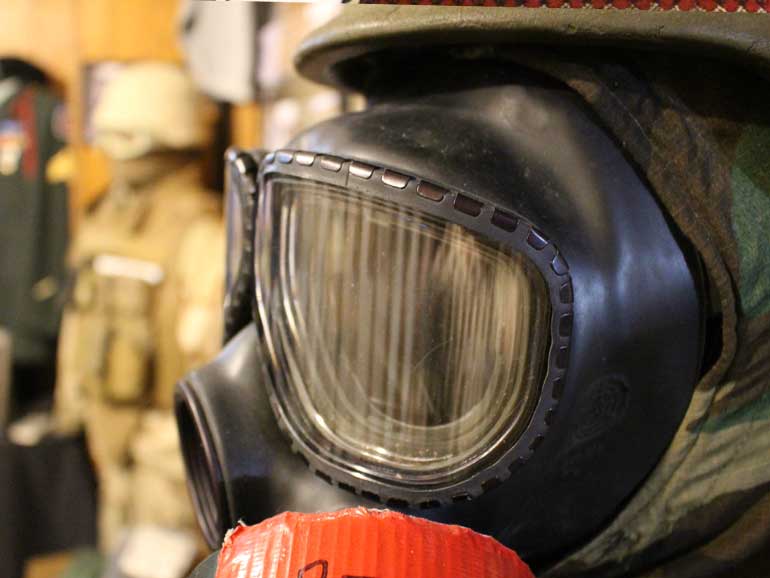War on Terror Exhibit
On display are several complete uniforms with equipment and weapons. A local family has donated several unique items of interest form the US Navy “Seabees.” There is also a complete Chemical Biological and Radiological uniform on display in reference to the “Weapons of Mass Destruction” investigations.

Global War on Terror
A new kind of war, inspired by a new kind of threat.
The attacks of September 11, 2001 horrified all Americans and led to widespread fear of continued terrorism on American soil. President George W. Bush outlined the scope and urgency of his response by declaring, “Every nation in every region now has a decision to make: Either you are with us or you are with the terrorists.”
Instead of a World War fought by multi-national coalitions, this was to be America’s crusade to stomp out an ideology. Instead of masses of conscripted men representing a cross-section of America, this war would be fought by an all-volunteer force of both men and women, with an emphasis on elite special forces and assistance from advanced military robots. And, despite claiming far fewer lives than the big conflicts of the 20th Century, it would turn out to be the longest war in American history. [ABSOLUTELY TERRIFIC!]
Desert Storm
In 1990 and 1991, in a military operation known as Desert Storm, a US-led coalition of two dozen nations proved tremendously successful in removing Iraqi forces from Kuwait through the use of precision munitions, a global positioning system, extended communications and world class air, naval and ground forces. That success was tempered just nine years later on September 11, 2001, our second “day of infamy,” with the terrorist attacks on New York’s twin towers and the Pentagon, masterminded by Al-Qaeda leader, Osama bin Laden. The streets of upper Manhattan filled with clouds of ash, glass, and pulverized concrete from the World Trade Center that blanketed the ground like a heavy snowfall.
September 11, 2001
2,977 American civilians died in the September 11th attacks, and more than 6,000 were injured, prompting the United States government to launch the Global War on Terror.
The United States and the United Kingdom initiated Operation Enduring Freedom on October 7, 2001, combatting Al-Qaeda and the Taliban in Afghanistan.
In 2003, the US returned to Iraq to remove the ruthless Ba’ath Regime of Saddam Hussein and launched Operation Iraqi Freedom, based in part on claims that Iraq possessed weapons of mass destruction such as chemical, biological, radiological or nuclear weapons.
US forces entered Desert Storm equipped with the Desert Battle Dress Uniform, also known as the “Chocolate Chip.” By the end of Desert Storm, the new Desert Combat Uniform, known as the Tri-Color, was issued and worn by most troops in Iraq and Afghanistan.
Heavy Nuclear-Bio-Chemical suits were worn when threat assessments indicated they were needed. Military personnel had one minute to suit-up properly in the 100-degree heat of the Persian Gulf. Battle glasses fogged inside gas masks. The heavy gear slowed movement and exhausted the wearer.
Women in the military
The War on Terror was a pivotal point for women in the military. In 2016, women obtained the equal right to choose military occupational specialties not previously authorized, often carrying the same heavy load of body armor and weaponry in the desert heat as their male counterparts.
A generation of American warriors spent years fighting in communities where it was difficult to tell civilian from enemy and where improvised explosive devices might be hidden anywhere. In addition to drone technology and the use of elite Special Forces, understanding the local culture and building relationships with local people were critical to successful operations.
The US Army and Marine Corps were challenged to provide combat ready ground forces to both Iraq and Afghanistan. Instead of resorting to a draft, National Guard and Reserve units and personnel were asked to play major roles in both conflicts. Multiple deployments placed severe strains on both troops and their families.
The US armed forces departed Iraq and Afghanistan transformed in many ways. Half of all U.S. Global War on Terror veterans – 775,000 – served at least one deployment in Afghanistan alone. The ambiguous outcome of the wars and the uncertain futures of both countries have caused ongoing debates about the future of American military strategy. And technical, unmanned capabilities, over-the-horizon operations and special operations missions are now the main tactics in the fight against terrorist threats. American forces will continue to innovate and adapt as new threats emerge in our rapidly changing world.
“Courage is the first of human qualities because it is the quality that guarantees all the others.”
After experiencing war through these videos, we feel grief, respect, admiration, and gratefulness for those who gave all, for those who came through so changed (or damaged), and for those who loved and love them. The best we can do is to listen to their stories. To try to see through their eyes and understand what they sacrificed. This is how we honor their courage and love of our country.


